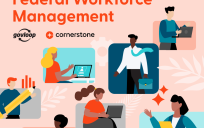For 15 months, federal teleworkers wondered what workplace fate would await them when COVID-19 cases and deaths declined and society reopened – a substantial question that added to the weight of an already heavy situation. Thursday, June 10, they got an answer.
The new “new normal” for the federal workforce will be a far more flexible environment, featuring more full- and part-time teleworkers and blended workplaces, according to the administration.
In a memo, the Office of Management and Budget (OMB) scrapped occupancy caps and set guidelines for imminent returns to offices, which agencies can commence after finalizing safety and reentry plans, settling collective bargaining, and notifying employees. But the order stopped far short of commanding employees back into the offices of old.
“The agency’s eventual post-pandemic operating state may differ in significant ways from the agency’s pre-pandemic operating state,” the new guidance states.
As for a brief timeline of what’s next, agencies must:
- By June 18, provide draft personnel policies for post-reentry
- By July 9, submit draft reentry schedules to OMB
- By July 19, finalize phased plans for reentry and post-reentry
Agencies must then give employees at least 30 days’ heads-up before calling them back into the office.
But even if an agency sets a return-to-office date, individuals’ situations and accommodations will be evaluated on their own merits.
“The amount of notice that agencies provide may vary based on the effect of the change on particular employees,” the guidance states. “For example, a newly hired employee who was authorized to work remotely during the pandemic may need more notice to allow for relocation than a local employee who will see a reduction in the number of telework days. Similarly, employees with school-aged children may be better able to adjust their schedules when the 2021-22 school year begins.”
These exceptions will be delegated down to the lowest level of decision-making, according to OMB, meaning that – in consultation with employees – direct supervisors will have the final say. OMB suggests agencies prepare reentry toolkits and guiding documents, as well as provide training for managers and employees.
In general, agencies can plan for a larger share of employees working remotely day to day, whether as part of hybrid schedules or a permanent arrangement. An important caveat is that to receive locality pay under the federal government’s General Schedule pay scale employees must report to the office at least twice a pay period.
The Office of Personnel Management intends to update its previous guidance on dependent care during telework, the memo notes. The document did not say when that might be.
Employees who are caregivers will be familiar with “maxiflex” schedules, meaning employees have total discretion for when they work as long as they’re online for core hours – sometimes just two hours on chosen days, often reserved for meetings – and still work the assigned amount of time. Agencies can continue to authorize maxiflex schedules in post-reentry work settings, and eligibility is not dependent on whether an employee is in or out of the office. OMB goes so far as to encourage alternative schedules and core hours.
“Federal employees have shown during the pandemic that they are able to balance work responsibilities with dependent care needs, including by taking breaks during regular working hours and making up the time after regular working hours,” OMB says.
Remote work, hybrid work and alternative hours are not piecemeal solutions for a scattered workforce, the administration believes. Instead, these flexibilities can save costs, power productivity and increase diversity in the long run.
“The transition to the post-reentry work environment offers a unique opportunity to update Federal agency strategies and policies related to the Federal workforce to be more future-focused,” the guidance states.





Leave a Reply
You must be logged in to post a comment.